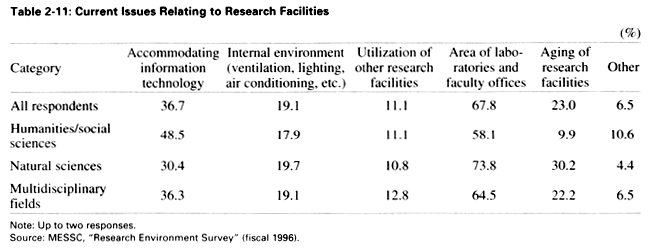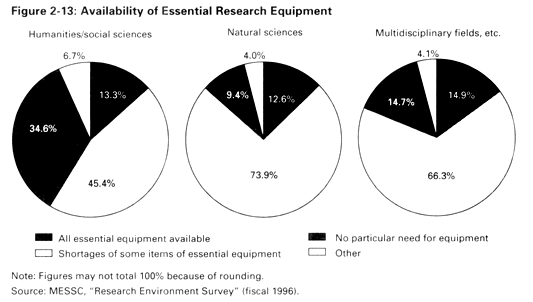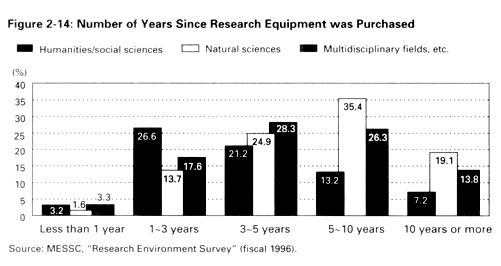| Home > Policy > White Paper, Notice, Announcement > White Paper > JAPANESE GOVERNMENT POLICES IN EDUCATION, SCIENCE, SPORTS AND CULTURE 1997 > Scientific Research Chapter 2 Section 1 3 | ||
The facilities where research takes place form an important part of the research infrastructure. MESSC is taking the following steps to meet the demand for facilities that will encourage the progress of scientific research in national universities and inter-university research institutes:
Other initiatives include setting up regional joint research centers and venture business laboratories.
In recent years the progressive overall deterioration and obsolescence of university facilities has brought about an annual increase in the number of buildings that need to be reconstructed or repaired. In fiscal 1997 approximately 52% of the buildings at national universities and inter-university research institutes had been standing for 20 years or more (Figure 11-4). What is more, the space available for research has become inadequate to accommodate the growth in the number of graduate and foreign students. The results of the "Research Environment Survey" show that 67.8% of researchers consider the size of laboratories and faculty offices to be the most important issue with respect to research facilities ( Table 2-11 ). The systematic improvement of research facilities is necessary, with particular emphasis on modernizing obsolete facilities and increasing the amount of space available for research.
To ensure that research facilities are utilized effectively, it will also be necessary to develop new ideas about how they are used, such as increasing joint utilization or cooperating with outside organizations.
Efforts are also being made to improve scientific research infrastructure in private universities by enhancing research facilities. The High Technology Research Center Development Program was launched in fiscal 1996 to provide comprehensive support with respect to the research facilities, equipment, and funds required for advanced research and development projects. In fiscal 1997 the Private University Scientific Frontier Promotion Program was established to provide comprehensive support for the development of joint research-promotion centers at research hubs.
Theoretical inquiry, as well as discovery and verification through experimentation, are essential to the progress of scientific research. The growing sophistication, precision, and scale of experimental research has been especially prominent in recent times, increasing the importance of experimental equipment. In addition, the use of computers, no longer limited to experimental research, has also become indispensable to theoretical research and research in the humanities and social sciences. As a result, the availability, capabilities, and precision of research equipment now have a real and significant bearing on the outcome and standard of research activities.
At the same time, qualitative deterioration and quantitative shortages of university research equipment have made improvement an important goal, which MESSC is striving to achieve.

Results from the "Research Environment Survey" show that 73.9% of researchers in natural science fields and 45.4% of those in the humanities and social sciences felt that there were shortages of some items of essential equipment ( Figure 2-13 ). Furthermore, 19.1% of researchers working in the natural sciences reported that key items of research equipment had been in use for 10 years or longer ( Figure 2-14 ).


| Back to Top | MEXT HOME |